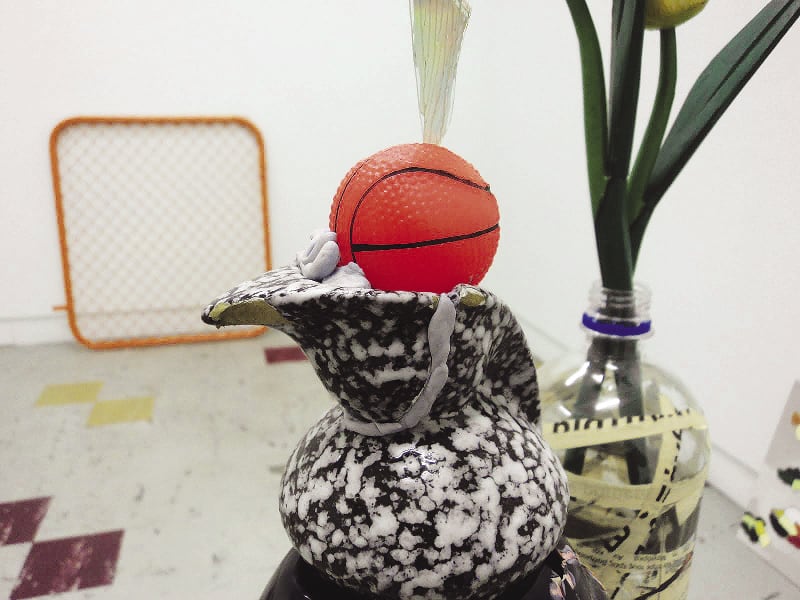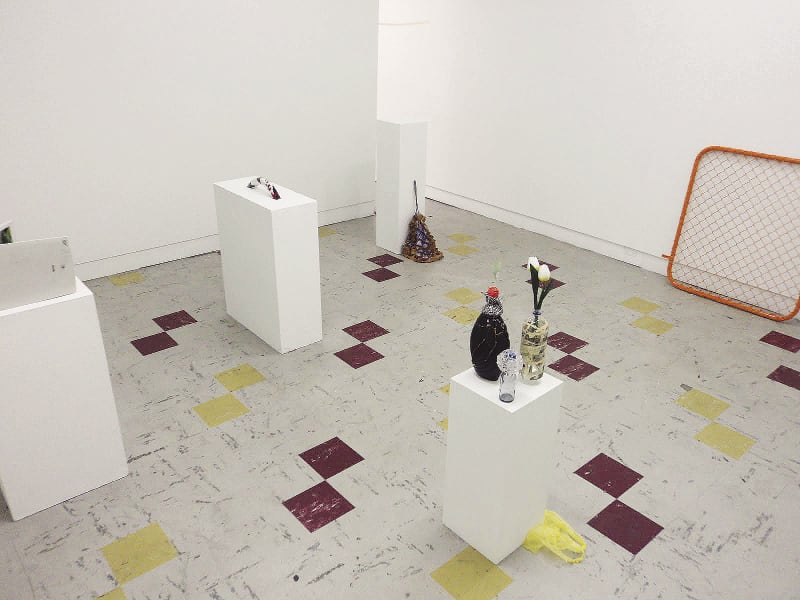TCB art inc., Melbourne, 2–19 February 2011,
organised by Kate Smith and Alex Vivian
Sculpture is an elastic and accommodating art form. When Gilbert & George, coated in metallic make-up, stood on a table and moved robotically to the music hall hit ‘Underneath the Arches’ in 1970, they invoked the medium by naming the performance Singing Sculpture. Similarly, when Robert Smithson released asphalt from the back of a dump truck down a gutted and gullied cliff (as part of Asphalt Rundown 1969) this action also became part of the discipline since, as Rosalind Krauss put it, he was making ‘sculpture in the expanded field’.1 The co-existence of these disparate works under the umbrella term ‘sculpture’ highlights that its definition is open to interpretation. Moreover, such examples suggest that testing the limits of the sculptural medium is where most of the excitement lies.

Another Yummy Fantasy II, held in the front gallery of TCB art inc., presented another playful take on this endlessly evolving form. With a subtitle that promised ‘a brief survey on some ideas behind Melbourne sculpture right now’, artists (and exhibition organisers) Kate Smith and Alex Vivian appeared conscious of presenting their close-knit group show in dialogue with the formal parameters of what it means to make sculpture. Works that adhere to the form’s most basic definition — as a self-contained, three-dimensional form in space — were positioned atop a series of museum-standard white plinths. This simple display mechanism was particularly interesting here since it signalled a clear departure from their earlier collaborations, including *tastes self* at Hell Gallery, Melbourne 2009 and Minnie the Moocher, at Melbourne’s The West Wing in early 2011, which favoured a far more chaotic approach. Presenting a large collection of artworks scattered across the gallery floor, these previous exhibitions understood sculpture as a progressive, dispersed activity.
Reverting to the notion of sculpture as a finished or discrete object, Another Yummy Fantasy II assumed something akin to historical posturing. Or, perhaps more to the point, the pared back display isolated each contribution, allowing for greater focus on the particularities and uncanny inversions of the individual works. For example, the re-sealed fault lines in Christopher LG Hill’s delicately reconstructed ceramic vases and the dexterity required to produce Vivian’s Scally (Squashed Against) Glass 2011 (a multi-coloured T-shirt is packed incredibly tightly inside a clear, arch-shaped tube), could easily be overlooked in a more unruly setting.
By Smith and Vivian’s own admission, the claim that Another Yummy Fantasy II might provide any comprehensive revelations was tongue-in-cheek: by no means was it meant to ‘represent or define what is going on in the 3D world at the moment’.2 While I acknowledge the impossibility for an unassuming show in an ARI to adequately capture the many ideas informing current sculpture practices, I also believe this bold subtitle is more telling than originally conceived. Granted, the exhibition had an air of in-house exclusivity — grouping together artist friends of Smith and Vivian.^3 Despite this focus on a certain sub-section of Melbourne art, Another Yummy Fantasy II accounted for an emerging aesthetic style.
Much of the work released functional forms from their usual task. The bright orange gate removed from its hinges which forms James Deutsher’s Orange Design 2011 appeared made for a public space yet, positioned inside the gallery, was entirely stripped of its normal utility. Similarly, Liv Barrett and Joshua Petherick’s collaborative piece, Conceptual Midori 2011, featured an open scanner turned on its side, acting as a support for a glass resin vase complete with foliage. Not only do works such as these manage to re-purpose everyday objects in a thoughtful and surprising manner — so that they may be reduced and admired on a purely aesthetic level; they act as an indicator of our post-Duchampian condition where readymades are implicitly accepted as an artist’s base material.
Despite paying lip service to the traditions of sculpture, the seven artists operated in an ambiguous, even disobedient, zone. The use of plinths occurred in a subversive, light-hearted manner, with any sense of gravitas undermined by their unconventional use. For example, Ash Kilmartin’s handcrafted leather and silk sack, The Travelling Mime 2011, hung low from the side of a plinth, slumping to the ground rather than perching atop; while a plastic shopping bag casually peeked out from underneath Hill’s base. Furthermore, the fragility and non-monumentality of Hill’s cracked vessels and balanced CD shards occurred in opposition to a solid, large-scale and labour-intensive monolith — the most customary form of sculpture. Such materially provisional, structurally precarious assemblages were a key element of Another Yummy Fantasy II, with extravagant gestures giving way to a far more casual approach to art-making.
In opposition to practices that impose rules and structures (as recently seen in Reason and Rhyme at Gertrude Contemporary, Melbourne, 2011, which contained work by artists who channel creative production through regimented systems such as grids and frameworks), Another Yummy Fantasy II was comparatively uninhibited and exuberant. The assemblages can be considered part of a growing current in contemporary art that concerns itself with the interactive potentialities of material and media, as identified by art historian Terry Smith. Specifically, this current advances the everyday occasioning of art, rejecting gratuitous provocation and grand symbolic proclamations in favour of small-scale and modest offerings.4
Kate Smith’s contribution to the exhibition was an abstract oil painting propped against the gallery wall, American Hobo Culture 2011, which seemed a clear anomaly in a show structured around sculptural practice. But perhaps the point was its very lack of sculptural qualities, suggesting that the definition of sculpture today has expanded so far to include everything it is not. Another Yummy Fantasy II provided an important detour, continuing to prohibit the medium from ever becoming lifeless or moribund.
*Patrice Sharkey is a curatorial assistant at Monash University Museum of Art, a gallery assistant at Sutton Gallery and Centre for Contemporary Photography, Melbourne, and Sub-editor of un Magazine, volume 5.*

